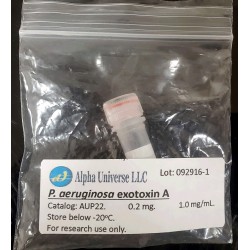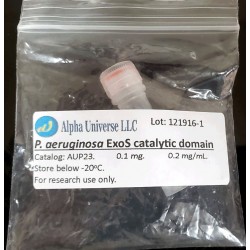Pseudomonas aeruginosa
Pseudomonas Exotoxin A (PE) is the most toxic virulence factor of the pathogenic bacterium P. aeruginosa. This toxin is secreted into the extracellular environment. It molecule is formed by a single polypeptide chain that latter is cleaved by mammalian protease furin to form so-called Active and Binding components. 3D structure of PE has three domains: I (composed of Ia and Ib sub-domains), II and III. Domain Ia (residues 1–252) is responsible for cell recognition. It is a highly specific ligand to the LDL/α2-macroglobulin receptor. Domain II (residues 253–364) possess the furin-cleavable motif (aa 274–280, RHRQPRG) and is involved in translocation of the toxin across membranes. Domain Ib (residues 365–404) is still unclear for its function. Domain III (residues 405–613) catalyze the ADP-ribosylation of elongation factor-2. This modification inactivates eEF-2 and the protein biosynthesis of the host cell comes to a standstill. As a consequence, apoptosis is induced and the host cell irreversibly dies.
ExoS is a bifunctional toxin that is injected directly into host cells. It has two distinct functional domains. The N terminus (amino acids 96-233) encodes a GTPase-activating protein (GAP) activity, whereas the C terminus (amino acids 234-453) encodes a factor-activating ExoS-dependent ADP-ribosyltransferase (ADPRT) activity. The GAP activity inactivates the Rho GTPases Rho (Rac, and Cdc42), whereas the ADPRT activity modifies a variety of host cell substrates, including Ras, ezrin/radixin/moesin (ERM), Rab5, and cyclophilin A.


